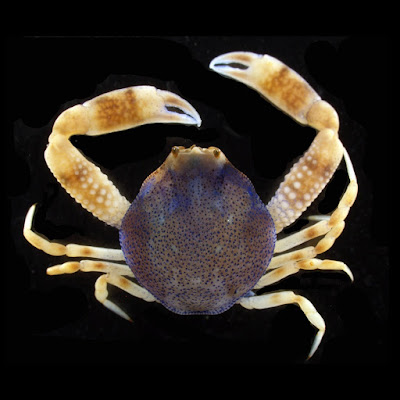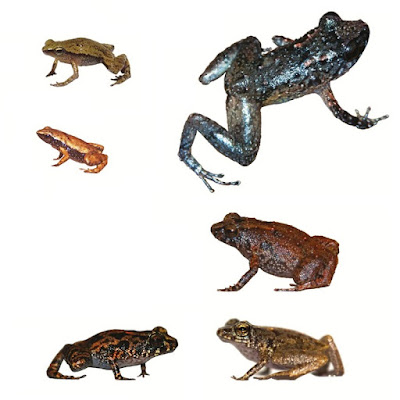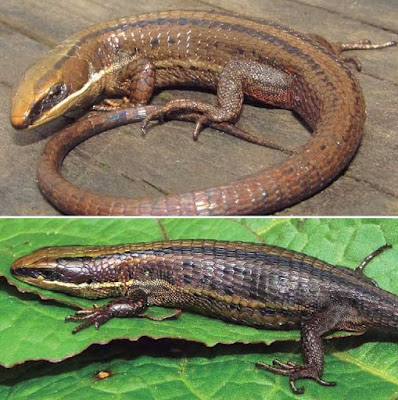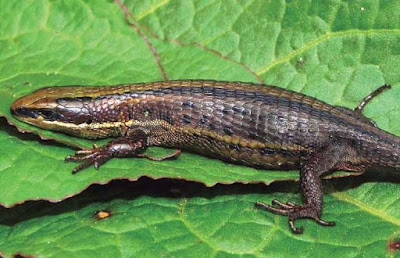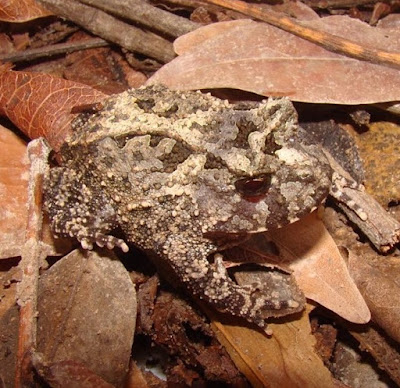[Most Recent Entries] [Calendar View]
Thursday, January 24th, 2019
| Time | Event | ||||||
| 3:58a | [Crustacea • 2019] Pseudophilyra parilis • A New Species of Pseudophilyra (Decapoda: Brachyura) from Japan, and Redescription and New Records of A poorly known Leucosiid Crab, Pseudophilyra punctulata
Abstract A poorly known leucosiid crab, Pseudophilyra punctulata Chen & Ng, 2003, originally described on the basis of an immature male holotype and an immature female paratype from Singapore, is rediscovered and rediagnosed on the basis of material from Thailand, the Philippines and the Ryukyu Islands (Japan). In addition, a new species closely related to P. punctulata, P. parilis, is described and illustrated on the basis of material from Mie Prefecture, Honshu mainland of Japan. The new species is distinguished from P. punctulata by the coarser granules bordering the lateral carapace margins and the different shape of the gonopods. Pseudophilyra tridentata Miers, 1879, is also compared with P. punctulata and P. parilis n. sp. because of the close similarities in the overall morphology of the carapace and appendages, but can easily be differentiated by the smoother carapace and thoracic sternum surface, different shape of the carapace and the stouter cheliped palm. It is possible that previous records of P. tridentata outside Japan might contain more than one species. Keywords: Crustacea, Pseudophilyra parilis, Pseudophilyra tridentata, Thailand, Philippines, Ryukyu Islands Leucosiidae Samouelle, 1819 Ebaliinae Stimpson, 1871 Pseudophilyra Miers, 1879 Pseudophilyra parilis n. sp. [New Japanese name: Hamabe-kobushi-modoki] Distribution. Presently known only from the type locality, Funakoshi, Daiou-cho, Shima, Mie Prefecture, Japan; intertidal to shallow subtidal sand bottom. Etymology. From the Latin “parilis” (adj., similar), in reference to the close similarity of the new species to Pseudophilyra punctulata. Komai Tomoyuki, Miho Shimetsugu and Peter K. L. Ng. 2019. Redescription and New Records of A poorly known Leucosiid Crab, Pseudophilyra punctulata Chen & Ng, 2003, and Description of A New Species of Pseudophilyra from Japan (Crustacea: Decapoda: Brachyura). Zootaxa. 4550(2); 251–267. DOI: 10.11646/zootaxa.4550.2.6 | ||||||
| 6:09a | [Herpetology • 2019] Endemic, Endangered and Evolutionarily Significant: Cryptic Lineages in Seychelles' Frogs (Anura: Sooglossidae)
Abstract Cryptic diversity corresponding with island of origin has been previously reported in the endemic, geographically restricted sooglossid frogs of the Seychelles archipelago. The evolutionary pattern behind this has not been fully explored, and given current amphibian declines and the increased extinction risk faced by island species, we sought to identify evolutionarily significant units (ESUs) to address conservation concerns for these highly threatened anurans. We obtained genetic data for two mitochondrial (mtDNA) and four nuclear (nuDNA) genes from all known populations of sooglossid frog (on the islands of Mahé, Praslin and Silhouette) for phylogenetic analyses and to construct nuDNA haplotype networks. Bayesian and maximum likelihood analyses of mtDNA support the monophyly and molecular differentiation of populations in all species that occur on multiple islands. Haplotype networks using statistical parsimony revealed multiple high-frequency haplotypes shared between islands and taxa, in addition to numerous geographically distinct (island-specific) haplotypes for each species. We consider each island-specific population of sooglossid frog as an ESU and advise conservation managers to do likewise. Furthermore, our results identify each island lineage as a candidate species, evidence for which is supported by analyses of mtDNA based on Bayesian Poisson tree processes, and independent analyses of mtDNA and nuDNA using the multispecies coalescent. Our findings add to the growing understanding of the biogeography and hidden diversity within this globally important region. Keywords: candidate species, cryptic diversity, evolutionarily significant unit, Indian Ocean, insular amphibians, islands, Sechellophryne, Seychelles, Sooglossidae, Sooglossus Jim Labisko, Richard A. Griffiths, Lindsay Chong-Seng, Nancy Bunbury, Simon T. Maddock, Kay S. Bradfield, Michelle L. Taylor and Jim J Groombridge. 2019. Endemic, Endangered and Evolutionarily Significant: Cryptic Lineages in Seychelles' Frogs (Anura: Sooglossidae). Biological Journal of the Linnean Society. bly183 DOI: 10.1093/biolinnean/bly183 @SeyAmphibians @Simon_Maddock @BiolJLinnSoc | ||||||
| 6:41a | [Herpetology • 2019] Pholidobolus paramuno • A New Species of Pholidobolus (Squamata: Gymnophthalmidae) from the Paramo Ecosystem in the Northern Andes of Colombia
Abstract On the basis of morphological and molecular evidence, we describe a new species of lizard of the genus Pholidobolus, previously conflated with P. vertebralis, from a paramo ecosystem in the northern Cordillera Central of Colombia. Our results support the recognition of the new species and suggest it is not closely related to P. vertebralis. Morphologically, the new species is distinguished from its congeners by coloration pattern, scutelation and hemipenial morphology. In light of the new evidence, we discuss the validity of available names, putative synapomorphies and the biogeography of the genus Pholidobolus in its northern distribution. KEYWORDS Antioquia, Cercosaurinae, Hemipenes, Molecular phylogenetics, taxonomy
Pholidobolus paramuno sp. nov. Prionodactylus vertebralis Uzzell, 1973: 6 (part). Cercosaura vertebralis Hernandez-Ruz and Bernal, 2011 (part). Cercosaura vertebralis Doan and Cusi, 2014: 1197 (part). Etymology. The specific epithet is an adjective referring to the word paramo, a high-altitude ecosystem restricted to the northern Andes of South America, where all specimens of the new species were found. Juan P. Hurtado-Gómez, Juan C. Arredondo, Pedro M. Sales Nunes and Juan M. Daza. 2018. A New Species of Pholidobolus (Squamata: Gymnophthalmidae) from the Paramo Ecosystem in the Northern Andes of Colombia. South American Journal of Herpetology. 13(3); 271-287. DOI: 10.2994/SAJH-D-15-00014.1 Resúmen: Con base en datos morfológicos y moleculares, describimos una especie nueva de lagartija del género Pholidobolus de un páramo al norte de la Cordillera Central de Colombia, la cual previamente había sido asociada con P. vertebralis. Nuestros resultados soportan el reconocimiento de la nueva especie y sugieren que no se encuentra cercanamente emparentada con P. vertebralis a pesar de su cercana distribución. Morfológicamente, la nueva especie se diferencia de los otros miembros del género por su patrón de coloración, escamación y morfología hemipeniana. A la luz de la nueva evidencia, discutimos la validez de nombres disponibles, sinapomorfias putativas y la biogeografía para el género Pholidobolus en su distribución más norte. | ||||||
| 9:54a | [Herpetology • 2018] Proceratophrys ararype • A New Species of Proceratophrys (Anura: Odontophrynidae) from the Araripe Plateau, Ceará State, Northeastern Brazil
Abstract Natural rain forest enclaves in northeastern Brazil (called Brejos de Altitude) are present in isolated areas surrounded by the semiarid Caatinga biome. Among these montane areas, the Araripe Plateau in Ceará state harbors Caatinga, Cerrado, and Atlantic Forest remnants and is considered a priority area for biodiversity conservation. Herein, we describe a new species of Proceratophrys (Amphibia: Anura: Odontophrynidae; Horned Frogs) endemic to the Araripe Plateau. Based on nuclear and mitochondrial DNA sequences, we show that this new species is related to the Amazonian species P. concavitympanum but can be diagnosed based on the row of tubercles on the forearm and by the number, size, and disposition of tubercles on the dorsal region. It is also widely disjunct, known only from the mesic forests of the Araripe Plateau, 2400 km away from the type locality of P. concavitympanum. The new species depends on streams for reproduction and is currently known from an area that is severely impacted by deforestation and diversion of local streams for agriculture and recreation. Considering the many threatened species occurring in the same region, there is a need for future studies to quantify the new species' full distribution and evaluate population trends to correctly assess its conservation status. Keywords: Brejos de Altitude, Caatinga biome, Horned Frogs, Phylogeny, Pleistocene
Proceratophrys ararype sp. nov. (Figs. 1–3) Proceratophrys cristiceps Ribeiro et al. 2012 Proceratophrys aridus Ferreira-Silva et al. 2016 (in part) Etymology.—The Araripe Plateau spans the borders of Ceará, Pernambuco and Piauí states. ‘‘Araripe,’’ from the ancient tupi, ararype, means ‘‘on the Araras River’’ (arara, arara + ’y, river + pe, on the; Arara means Macaw in Tupi and in vernacular Portuguese). Because the new species is known only from the Araripe region, we name it after this area. The specific epithet ararype is treated as a noun in apposition Sarah Mângia, Ricardo Koroiva, Pedro M. Sales Nunes, Igor Joventino Roberto, Robson W. Ávila, Anathielle Caroline Sant'Anna, Diego J. Santana and Adrian A. Garda. 2018. A New Species of Proceratophrys (Amphibia: Anura: Odontophrynidae) from the Araripe Plateau, Ceará State, Northeastern Brazil. Herpetologica. 74(3); 255-268. DOI: 10.1655/Herpetologica-D-16-00084.1 |
| << Previous Day |
2019/01/24 [Calendar] |
Next Day >> |
